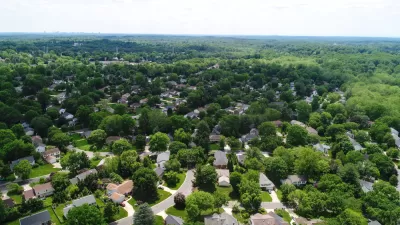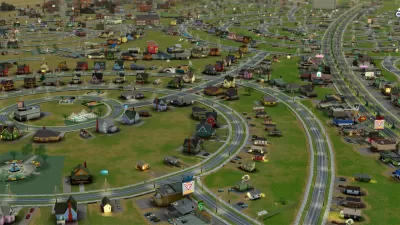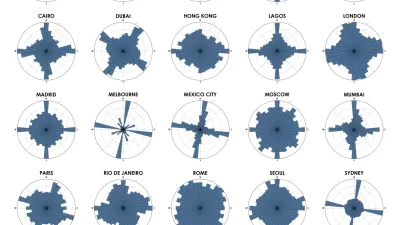Smart growth supporters tend to prefer grid systems to cul-de-sacs, for excellent reasons. A proliferation of cul-de-sacs artificially lengthens walking distances: if streets don’t connect to each other, you might have to walk a mile to go just a few hundred feet. In addition, cul-de-sacs increase traffic congestion by dumping most vehicular traffic on a few major streets. And because biking is less safe on busy, high-traffic streets, bikers benefit from a grid system as well.
Smart growth supporters tend to prefer grid systems to cul-de-sacs, for excellent reasons. A proliferation of cul-de-sacs artificially lengthens walking distances: if streets don't connect to each other, you might have to walk a mile to go just a few hundred feet. In addition, cul-de-sacs increase traffic congestion by dumping most vehicular traffic on a few major streets. And because biking is less safe on busy, high-traffic streets, bikers benefit from a grid system as well.
But banning cul-de-sacs on residential streets might go too far: many homeowners understandably prefer cul-de-sacs because of the absence of "cut through traffic" on those streets (that is, traffic cutting through from one major street to another). Is there a middle ground between current subdivision ordinances (which sometimes require new subdivisions to be dominated by cul-de-sacs) and wiping out cul-de-sacs altogether?
One option might be for government to neither encourage nor discourage cul-de-sacs. It seems to me that this result would clearly be preferable to the status quo, as it maximizes consumer choice while reducing at least some of the social harms caused by cul-de-sacs.
On the other hand, one common justification for government regulation is to prevent situations where it makes sense for individuals to do X, but if lots of individuals do X, we all lose something. It could legitimately be argued that the prevalence of cul-de-sacs may be such a situation: if I live on the only cul-de-sac in the neighborhood, I have less traffic on my street (presumably a good thing) but still live in a basically walkable and uncongested neighborhood. But if everyone else lives on a cul-de-sacs, I have to suffer through all the disadvantages of cul-de-sacs as well: more traffic congestion because everyone has to drive on a couple of main streets, and reduced walkability as distances between houses multiply.
A second "middle ground" alternative is to allow cul-de-sacs in new subdivisions, but to create a quota limiting their number- for example, to provide that there be no more than one cul-de-sac for every intersection.This rule might accommodate consumer demand for cul-de-sacs, but would ensure that there were enough interconnected streets to accommodate driving, walking and biking.
A third compromise is the "fused grid." Under a fused grid street system, there is a grid of main streets and a set of cul-de-sacs branching off from those streets. But the difference between the fused grid and a cul-de-sac system is as follows: in the latter situation, there is nothing to connect one cul-de-sac to another, so walkers and bikers have to travel out of their way to reach other cul-de-sacs. By contrast, a fused grid "fuses" the cul-de-sacs with miniature parks or pathways designed for bicycles and pedestrians, thus allowing nondrivers to go from one house to another. When streets in an existing grid network are closed off to cars, something similar to a fused grid is created: cars are limited as in a cul-de-sac system, while pedestrians are as mobile as in a grid system.

Planetizen Federal Action Tracker
A weekly monitor of how Trump’s orders and actions are impacting planners and planning in America.

Restaurant Patios Were a Pandemic Win — Why Were They so Hard to Keep?
Social distancing requirements and changes in travel patterns prompted cities to pilot new uses for street and sidewalk space. Then it got complicated.

Map: Where Senate Republicans Want to Sell Your Public Lands
For public land advocates, the Senate Republicans’ proposal to sell millions of acres of public land in the West is “the biggest fight of their careers.”

Maui's Vacation Rental Debate Turns Ugly
Verbal attacks, misinformation campaigns and fistfights plague a high-stakes debate to convert thousands of vacation rentals into long-term housing.

San Francisco Suspends Traffic Calming Amidst Record Deaths
Citing “a challenging fiscal landscape,” the city will cease the program on the heels of 42 traffic deaths, including 24 pedestrians.

California Homeless Arrests, Citations Spike After Ruling
An investigation reveals that anti-homeless actions increased up to 500% after Grants Pass v. Johnson — even in cities claiming no policy change.
Urban Design for Planners 1: Software Tools
This six-course series explores essential urban design concepts using open source software and equips planners with the tools they need to participate fully in the urban design process.
Planning for Universal Design
Learn the tools for implementing Universal Design in planning regulations.
Heyer Gruel & Associates PA
JM Goldson LLC
Custer County Colorado
City of Camden Redevelopment Agency
City of Astoria
Transportation Research & Education Center (TREC) at Portland State University
Camden Redevelopment Agency
City of Claremont
Municipality of Princeton (NJ)






























